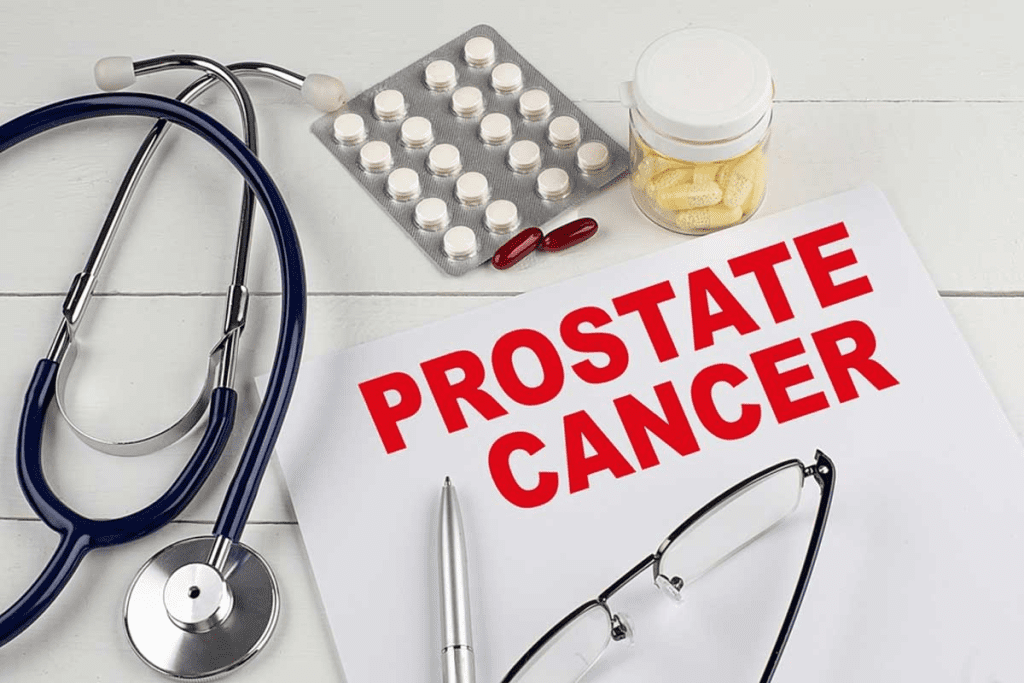Last Updated on November 26, 2025 by Bilal Hasdemir

Nearly 100% of men diagnosed with localized prostate cancer survive for five years or more.
Key Takeaways
- Survival rates for prostate cancer have improved.
- Early detection is key for survival.
- Localized prostate cancer has a high survival rate.
Understanding Prostate Cancer
Prostate cancer is a big worry for men, mainly in the United States. It’s important to know what prostate cancer is, how common it is, and how it starts. This helps us understand survival rates and its effect on men’s health.
| Year | New Cases | Survival Rate |
| 2018 | 164,690 | 99% |
| 2019 | 174,650 | 99% |
| 2020 | 191,930 | 99% |
Definition and Prevalence
Prostate cancer happens when cells in the prostate gland grow too much. It’s a common cancer in men in the United States.
How Prostate Cancer Develops
Prostate cancer starts with a mix of genetic and environmental factors. Knowing how it starts is key for finding it early and treating it.
How Survival Rates Are Measured
Survival rates are key to understanding how well patients with prostate cancer do. They show how likely someone is to survive for a certain time.
Relative Survival Rate: A Key Metric

The relative survival rate compares patients with prostate cancer to the general population. It shows how much a prostate cancer diagnosis can affect life expectancy.
| Survival Period | Relative Survival Rate |
| 5-year | 92% |
| 10-year | 85% |
| 15-year | 80% |
Understanding Survival Rates
Survival rates are measured over 5, 10, and 15 years. The 5-year rate shows the percentage of people alive 5 years after diagnosis. The 10-year and 15-year rates give insights into longer survival. The 5-year survival rate for prostate cancer is high. This shows how far we’ve come in early detection and treatment. But, it’s important to remember that survival rates are based on past data. They might not exactly predict what will happen to an individual.
Limitations of Survival Statistics
Survival statistics are useful but have their limits. They are based on big groups and might not accurately predict an individual’s outcome. Many factors, like overall health and the cancer’s stage, affect how well someone does.
Prostate Cancer Survival Statistics

Understanding prostate cancer survival statistics is vital for those affected by this disease. The overall survival rate for prostate cancer varies based on several factors, including the stage at diagnosis and the aggressiveness of the cancer.
Overall Survival Rates
According to the American Cancer Society, the overall survival rate for prostate cancer is quite promising. For men diagnosed with localized prostate cancer, the five-year survival rate is approximately 100%. This rate drops to around 29% for men diagnosed with distant metastasis, highlighting the importance of early detection and treatment.
Advanced Cancer Survival
Advanced prostate cancer survival rates are more challenging to predict. The five-year survival rate for men with locally advanced prostate cancer is about 93%. For those with distant metastasis, the five-year survival rate is significantly lower, at around 29%. These statistics underscore the need for ongoing research and effective treatment options for advanced prostate cancer. By examining these prostate cancer survival statistics, we can better understand the impact of early detection and treatment on patient outcomes. This knowledge is essential for improving overall survival rates and ensuring better care for those affected by this disease.
Prostate Cancer Survival by Stage
Knowing the survival rates for prostate cancer is key for patients and their families. The stage at diagnosis greatly affects the outlook. We’ll look at survival rates by stage, showing how early detection and treatment matter.
Stage 1 Prostate Cancer Survival Rate
Men with Stage 1 prostate cancer have a very good chance of survival. The 5-year survival rate is almost 100%. This is because the cancer is usually caught early and can be treated well with surgery or radiation.
Stage 2 Prostate Cancer Survival Rate
Stage 2 prostate cancer means the cancer is in the prostate but a bit more advanced than Stage 1. The 5-year survival rate is also high, around 100%. This is because treatments are usually effective.
Stage 3 Prostate Cancer Survival Rate
At Stage 3, the cancer has spread to tissues around the prostate. The 5-year survival rate is high but starts to drop compared to earlier stages. Treatment gets more complex, often needing a mix of therapies.
Stage 4 Prostate Cancer Survival Rate
Stage 4 prostate cancer is the most advanced, with cancer spreading to distant parts of the body. The survival rate at this stage is much lower than earlier stages. This highlights the critical need for early detection.
Localized Prostate Cancer Survival Outlook
Localized prostate cancer is a type of cancer that hasn’t spread beyond the prostate gland. It has a good survival rate because the cancer is contained. This makes it easier to treat with different options.
Definition of Localized Disease
Localized prostate cancer means the cancer is only in the prostate gland. It hasn’t spread to other tissues or parts of the body. Doctors often find it early with tests like the PSA test.
Survival Statistics for Contained Cancer
The survival rates for localized prostate cancer are very good. The 5-year survival rate is almost 100%. This means men with this cancer have a high chance of living at least 5 years after being diagnosed.
| Survival Period | Relative Survival Rate |
| 5-Year | 100% |
| 10-Year | 98% |
| 15-Year | 96% |
Treatment Options and Their Impact
There are many treatments for localized prostate cancer. These include surgery, radiation therapy, and active surveillance. The right treatment depends on the patient’s health, the cancer’s type, and what the patient prefers.
Surgery (Radical Prostatectomy): Taking out the prostate gland is a common treatment. It works well for cancer that’s only in the prostate.
Radiation Therapy: This uses high-energy rays to kill cancer cells. It can be the main treatment or used with others.
These treatments greatly improve survival chances. Many men are cured or live long with the cancer, thanks to early detection.
Advanced and Metastatic Prostate Cancer Prognosis
Knowing the prognosis for advanced and metastatic prostate cancer is key for patients and doctors. We must look at the latest research and how it affects patient care.
Understanding Metastatic Spread
When prostate cancer spreads to other parts of the body, it’s called metastatic. This happens when cancer cells move from the prostate to places like bones, lymph nodes, or other organs. It’s a complex process involving cancer cells and the body’s environment.
Key factors influencing metastatic spread include:
- The aggressiveness of the cancer cells
- The presence of genetic mutations
- The patient’s overall health and immune response
Survival Expectations with Distant Metastases
Thanks to new treatments, survival rates for metastatic prostate cancer have gone up. While each case is different, we’re seeing more people living longer.
Some key statistics include:
- Improved 5-year survival rates for patients with metastatic disease
- Increased use of targeted therapies and immunotherapies
- Better management of symptoms and side effects
New Treatments Improving Outcomes
New treatments have been added to help patients with advanced prostate cancer. These include new hormonal therapies, chemotherapy, and radiopharmaceuticals.
Notable advancements include:
- PARP inhibitors for patients with specific genetic mutations
- Immunotherapies that harness the power of the immune system
- Targeted therapies that focus on specific molecular targets
As we learn more about prostate cancer, we’ll see even better treatments. This is a hopeful time for those with advanced and metastatic prostate cancer.
Prostate Cancer Survival Rates Across Demographics
Prostate cancer survival rates change a lot depending on who you are. We’ll look at how survival rates differ by race, income, and where you live.
Racial Disparities
There’s a big issue with racial disparities in prostate cancer survival. African American men are more likely to get prostate cancer and die from it than white men.
| Ethnic Group | 5-Year Survival Rate | 10-Year Survival Rate |
| Caucasian | 99% | 95% |
| African American | 93% | 85% |
| Hispanic/Latino | 96% | 90% |
| Asian/Pacific Islander | 97% | 92% |
Socioeconomic Factors
Money and education can also affect survival rates. Men with less money or education might not get care as soon. This can lead to worse outcomes.
Geographic Variations
Where you live can also change your survival chances. Men in rural areas often have less access to top doctors. This can make treatment harder to get.
Prostate Cancer Treatment Outcomes
It’s important to know how different prostate cancer treatments work. These treatments have changed a lot, giving us many ways to fight the disease.
Surgery (Radical Prostatectomy)
Surgery, like radical prostatectomy, is a common choice for early prostate cancer. It means taking out the prostate gland and nearby tissues. Most people do well if the cancer is only in the prostate. New surgery methods, like robotic-assisted surgery, make it more precise and quicker to recover.
Radiation Therapy
Radiation therapy is also a good option for prostate cancer. It’s best for those who can’t have surgery or don’t want to. There are two main types: external beam radiation therapy (EBRT) and brachytherapy. EBRT uses beams from outside the body, while brachytherapy puts radioactive seeds inside the prostate. Both can help control the disease well.
Hormone Therapy
Hormone therapy, or androgen deprivation therapy (ADT), lowers male hormones that help cancer grow. It’s often used with other treatments like radiation. How well it works depends on the cancer stage and patient health.
Chemotherapy
Chemotherapy is for advanced prostate cancer that has spread. It uses drugs to kill cancer cells. While it’s not a cure for most advanced cases, it can ease symptoms and extend life. New drugs and combinations are being studied to better fight the disease. Each treatment has its own results and side effects. We help patients choose the best treatment for them, based on their situation and what they prefer.
Prostate Cancer Cure Rate
The idea of a “cure” for prostate cancer is complex. It involves many factors and outcomes. When we talk about curing prostate cancer, we mean the number of men who don’t get the disease back after treatment.
Definition of “Cure” in Prostate Cancer
In prostate cancer, a “cure” means the treatment got rid of the cancer. The patient is expected to live without the disease coming back. But the idea of a cure is not always simple. Prostate cancer can sometimes come back years later. To be considered “cured,” a patient must have complete remission. This means no cancer is found after treatment. Doctors check for this through regular tests, like PSA tests.
Statistics on Complete Remission
Statistics on complete remission help us understand how well treatments work. Many men with early or locally advanced prostate cancer can get rid of the disease with the right treatment. For example, men with early prostate cancer who have surgery or radiation therapy often get complete remission. The 5-year survival rate for early prostate cancer is almost 100%. This means most men live 5 years after being diagnosed.
Long-term Survival After Treatment
Long-term survival is key when we talk about curing prostate cancer. Thanks to better treatments, more men are living longer after treatment. In the United States, about 98% of men with prostate cancer survive 5 years after diagnosis. This number includes men who may have had the disease come back. Many things affect how long a man will live after treatment. These include the cancer’s stage, the treatment’s success, and the man’s overall health. Knowing these factors helps doctors and patients make better choices.
Prostate Cancer Recurrence and Survival
Prostate cancer recurrence is a big challenge for treatment and survival. It can show up in different ways, each affecting patient outcomes differently. Knowing these differences is key to finding effective treatments.
Biochemical Recurrence
Biochemical recurrence, or PSA recurrence, happens when PSA levels go up after treatment. This is a sign that cancer might be coming back. It’s a chance to act early and possibly improve survival chances.
Local vs. Distant Recurrence
Recurrence can be local or distant. Local recurrence means cancer comes back in the same spot. Distant recurrence, or metastasis, means it spreads to other parts of the body. How the cancer comes back affects treatment and survival chances.
| Type of Recurrence | Characteristics | Survival Impact |
| Local Recurrence | Cancer returns in the original site | Generally better survival rates with appropriate treatment |
| Distant Recurrence | Cancer spreads to other body parts | Survival rates vary based on metastasis extent and treatment response |
Survival After Recurrence
Survival after recurrence depends on many things. These include the type of recurrence, overall health, and how well treatment works. New treatments have helped improve survival chances for those with recurrent prostate cancer.
Treatment Options for Recurrent Disease
Treatment for recurrent prostate cancer is chosen based on individual needs. This includes where the cancer came back and what treatments were tried before. Options might include salvage radiation, hormone therapy, chemotherapy, or clinical trials. The right treatment is important for survival.
Aggressive Prostate Cancer Survival Rates
Understanding aggressive prostate cancer is key to improving survival rates. This type of cancer is complex and needs a detailed treatment plan. We will look at the signs of high-risk disease, treatment options, and how genetics play a role.
High-Risk Disease Characteristics
High-risk prostate cancer has several signs. These include a high Gleason score, high PSA levels, and cancer in many biopsy samples. These signs mean the cancer might spread and grow faster.
Key Features of High-Risk Prostate Cancer:
- Gleason score of 8 or higher
- PSA level above 20 ng/mL
- Clinical stage T3 or T4
- Presence of cancer in multiple biopsy cores
Treatment Approaches and Outcomes
Treatment for aggressive prostate cancer usually involves more than one therapy. The right treatment depends on the cancer’s stage, the patient’s health, and other factors.
| Treatment Approach | Description | Outcomes |
| Radical Prostatectomy | Surgical removal of the prostate | Potential for cure if cancer is localized |
| Radiation Therapy | High-energy rays to kill cancer cells | Effective for local control of cancer |
| Hormone Therapy | Reducing testosterone levels to slow cancer growth | Can improve survival in advanced cases |
Genetic Factors in Aggressive Disease
Genetics are very important in prostate cancer. Some genetic changes can make the cancer more aggressive.
Genetic Mutations Associated with Aggressive Prostate Cancer:
- BRCA1 and BRCA2 mutations
- TP53 mutations
- PTEN mutations
Knowing about these genetic factors helps doctors find and treat high-risk patients better.
Prostate Cancer Mortality and Death Rate
The death rate from prostate cancer has been going down. This is thanks to better treatments and early detection. These improvements are making a big difference in patient care.
Current Statistics in the United States
Prostate cancer death rates in the U.S. have dropped a lot. The American Cancer Society says the death rate has fallen by about 52% in the last 20 years. This is because of better screening and treatment options.
| Year | Prostate Cancer Death Rate |
| 2000 | 30.4 per 100,000 men |
| 2010 | 23.1 per 100,000 men |
| 2020 | 18.3 per 100,000 men |
The table shows a steady drop in prostate cancer death rates. This proves that current medical practices are working well.
Common Causes of Death in Advanced Disease
In advanced prostate cancer, death often comes from the cancer spreading to other parts of the body. This can include bones, lymph nodes, or other organs. “The most common sites for prostate cancer metastasis are the bones and lymph nodes,” a study found.
“Understanding the patterns of prostate cancer spread is key for better treatment,” – A top oncologist said.
Trends in Mortality Reduction
The drop in prostate cancer deaths is thanks to better screening, diagnosis, and treatment. Early detection through PSA tests helps catch cancers early. Also, new surgical, radiation, and hormone therapies are helping patients live longer. We’re seeing prostate cancer death rates keep going down. This shows how modern medicine is improving patient outcomes. As research keeps going and new treatments come, we expect to see even more reductions in death rates.
Improving Your Prostate Cancer Survival Outlook
To improve survival rates for prostate cancer, a mix of medical treatment, lifestyle changes, and regular checks is key. Understanding what affects survival and taking action can boost your chances.
Lifestyle Modifications
Eating well and staying active are important. A diet full of fruits, veggies, and whole grains, along with regular exercise, can help your health. This might also help your cancer treatment work better.
Treatment Adherence
Sticking to your treatment plan is essential. This means taking your medicine as told, going to all your doctor’s appointments, and making lifestyle changes as suggested.
Regular Monitoring and Support
Regular check-ups help catch any changes in your cancer. Using resources like counseling, support groups, and educational materials can also help with your emotional and mental health.
| Factor | Description | Benefit |
| Healthy Diet | Rich in fruits, vegetables, and whole grains | Improves overall health and potentially cancer outcomes |
| Regular Exercise | Physical activity tailored to the individual’s health status | Enhances physical and mental well-being |
| Adherence to Treatment | Following the prescribed treatment plan | Improves survival rates and disease management |
Conclusion
Knowing about prostate cancer survival rates is key for patients to make smart choices about their health. We’ve looked at how different things affect survival, like the cancer’s stage, treatment choices, and personal health. Managing prostate cancer well means more than just treatment. It also includes making healthy lifestyle changes and keeping up with check-ups. This shows that many patients have a good chance of survival, thanks to early detection. Thanks to new medical discoveries and a deeper understanding of the disease, the outlook for prostate cancer is getting better. It’s vital to have a care plan that fits each person’s needs and situation. Patients can improve their chances of beating prostate cancer by staying informed and teaming up with their doctors. This way, they can get the best results possible.
FAQ
What is the overall survival rate for prostate cancer?
The survival rate for prostate cancer is high, mainly when caught early. The 5-year survival rate for all stages is nearly 100%.
How is prostate cancer survival rate measured?
Survival rates are measured by comparing men with prostate cancer to the general male population. Rates are given for 5, 10, and 15 years.
What is the survival rate for localized prostate cancer?
Men with localized prostate cancer have a 5-year survival rate of nearly 100%. This means they have almost the same chance of survival as men without the disease.
How does the stage of prostate cancer at diagnosis affect survival?
The stage at diagnosis greatly impacts survival. Stage 1 has a very high survival rate. Stage 4 has a lower rate.
What are the survival expectations for advanced and metastatic prostate cancer?
Survival for advanced or metastatic prostate cancer varies. The 5-year survival rate is lower than for localized disease. Yet, new treatments are improving outcomes, and some men live for many years.
How does age at diagnosis affect prostate cancer survival?
Age at diagnosis affects survival. Older men generally have lower survival rates due to other health issues.
What is the impact of Gleason score on prostate cancer survival?
The Gleason score, which shows cancer aggressiveness, is key to survival. Higher scores mean a poorer prognosis.
Can prostate cancer be cured?
Many men can be cured of prostate cancer, mainly if caught early. Treatments like surgery and radiation can effectively remove the disease.
What are the treatment outcomes for prostate cancer?
Outcomes vary based on stage and treatment. Surgery, radiation, hormone, and chemotherapy are common. Early-stage disease outcomes are generally good.
How can men improve their prostate cancer survival outlook?
Men can boost their survival chances by making lifestyle changes, following treatment plans, and getting regular check-ups. Support resources also help.
What are the racial and ethnic disparities in prostate cancer survival?
There are big disparities in survival rates, with African American men facing lower rates than white men. These disparities stem from healthcare access and disease aggressiveness.
What is the prostate cancer mortality rate in the United States?
The mortality rate has been falling due to better treatments and early detection. Yet, prostate cancer remains a leading cause of death in men.
How does prostate cancer recurrence affect survival?
Recurrence can impact survival, but the effect varies. Treatment options exist for recurrence, and some men live for years after.
What is the survival rate for aggressive prostate cancer?
Survival for aggressive prostate cancer is generally lower. Yet, new treatments are improving outcomes, and some men with aggressive cancer can survive long-term.
What are the common causes of death in advanced prostate cancer?
Common causes of death in advanced cancer include disease progression, heart disease, and other health issues.
References
- National Cancer Institute. (2024). Prostate Cancer Treatment (PDQ ®)“Patient Version.https://www.cancer.gov/types/prostate/patient/prostate-treatment-pdq






